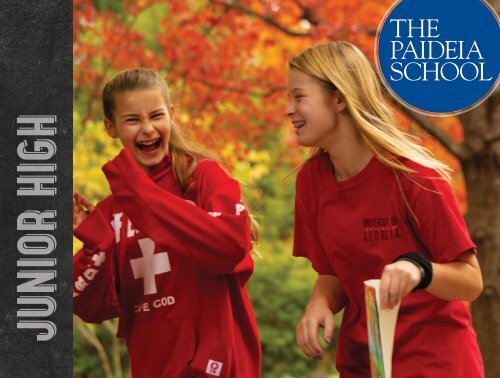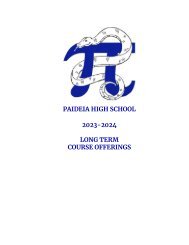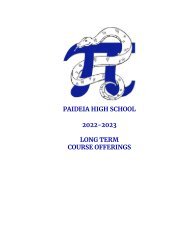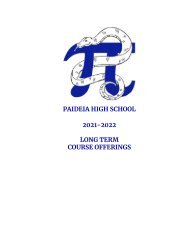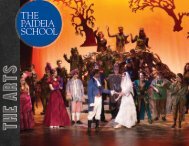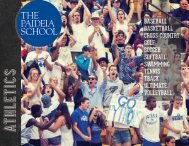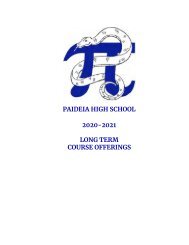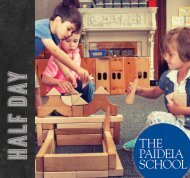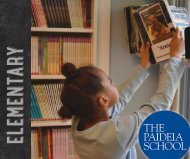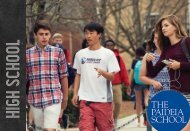JH_ISSUU
Create successful ePaper yourself
Turn your PDF publications into a flip-book with our unique Google optimized e-Paper software.
CHANGING TIMES<br />
The junior high years – in Paideia’s case, the seventh and<br />
eighth grades – are sometimes considered the most<br />
challenging and fascinating time of one’s life. Physical,<br />
intellectual, and emotional changes are rapid and intense<br />
at this age. Kids feel that they are no longer children; while<br />
they’re eager for the greater freedoms and responsibilities<br />
of teenage life, they’re also filled with self-doubt and are<br />
apprehensive about the social conflicts and increased<br />
academic pressures that lie ahead. Though they constantly<br />
try out new roles for themselves and might seek to distance<br />
themselves from their parents, they still need and want the<br />
support and guidance of the key adults in their lives.<br />
This age of transition has typically been difficult for schools<br />
to handle. There is a wide range in skills and maturity at this<br />
age. Within one classroom, students who can think and write<br />
at a high school or even college level sit next to others who<br />
are still fairly young intellectually. Even within individual kids<br />
there can be wide fluctuations. A seventh or eighth grader<br />
can behave like a 16-year-old one day and like a 10-year-old<br />
the next. To deal with these competing factors, most studies<br />
have recommended smaller and more flexible schools, more<br />
individual attention and guidance from teachers, and more<br />
opportunities for reflection and self-expression. We have<br />
developed a program at Paideia that we think is especially<br />
suited to deal with the needs and opportunities of early<br />
adolescence. It combines close contact and support from<br />
teachers with independence, individual responsibility, and<br />
a wide range of choices. It demands a lot from students but<br />
does so in comfortable surroundings where they can feel at<br />
home. We emphasize core subjects such as math and writing,<br />
but also employ a creative curriculum designed to develop<br />
self-awareness and expression. And, it’s all presided over<br />
by teachers who genuinely enjoy and appreciate children<br />
of this age.
Atmosphere<br />
Classrooms are openly arranged with sofas, tables, and<br />
chairs. Kids don’t line up to go places, there are no bells<br />
between class periods, and one doesn’t need permission<br />
to go to the water fountain. The academic expectations<br />
are high, but the atmosphere is informal. We believe that<br />
this environment helps students feel more at home and at<br />
ease. Comfort is especially valuable for junior high kids,<br />
for whom a certain degree of fidgeting and sprawling is as<br />
inevitable as breathing. They need lots of elbow and knee<br />
room; they were never intended to sit in desks for hours<br />
on end.<br />
Another somewhat unusual feature of the school is that<br />
teachers are called by their first names. Teachers and<br />
students get to know each other very well here, and that<br />
makes calling them “Mr.” or “Mrs.” seem out of place. Still,<br />
there’s no doubt who’s in charge; kids know that calling<br />
teachers “Kemi” or “Tony” does not make them peers or<br />
make assignments and expectations any less serious.
Faculty<br />
The teachers, more than any other variable, set the tone<br />
and atmosphere of the school day. One of Paideia’s guiding<br />
principles has been to find experienced, talented, and<br />
innovative faculty and give them room to teach. There is<br />
no particular educational ideology imposed on teachers;<br />
their classes tend to be reflections of their styles and<br />
enthusiasms. Some seem to teach by force of personality<br />
and need little external structure to do so. Others see<br />
themselves as organizers and facilitators in the learning<br />
process. Some are very systematic in their approach, while<br />
others rely more on inspiration. Some are effusive and<br />
affectionate, while others are more formal or subdued. But,<br />
they all share two things: they enjoy being around children<br />
this age, and they believe they can make a positive impact<br />
on the lives of their students.<br />
Paideia has junior high teachers who<br />
approach the early adolescent experience<br />
with a sense of adventure, patience,<br />
compassion, and above all,<br />
a sense of humor.
Goals and<br />
Expectations<br />
We have high hopes and expectations for our junior high<br />
students. At such a pivotal time in their lives, we want<br />
school to be a place where students are challenged and<br />
supported, where they acquire the skills they need but also<br />
do a lot of things they enjoy, and where they learn to look at<br />
themselves honestly and appreciate what they see. We want<br />
them to emerge from eighth grade confident, accomplished,<br />
and ready for the world of high school. Junior high is a time<br />
when it’s still okay to struggle, and even to fail, as long as<br />
one can learn from one’s mistakes. We think this is the best<br />
time for students to stumble, deal with some doubts, and<br />
ultimately experience breakthroughs.<br />
Because of this perspective, when we evaluate junior high<br />
students and talk to parents about how their children are<br />
doing, our chief concerns are not so much with grades<br />
and test scores, but with how they are dealing with this<br />
multifaceted, two-year process. Perhaps the greatest<br />
advantage of having interdisciplinary homebase classrooms<br />
is that our teachers get to know their students very well, and<br />
The skills<br />
Over the course of their junior high years, there are<br />
skills that we want students to develop and practice.<br />
We want them to be able to:<br />
» Organize and discipline themselves<br />
to get things done<br />
» Express ideas clearly and fully, in<br />
writing and when speaking<br />
» Think critically and deeply about a<br />
variety of subjects<br />
» Learn and absorb new ideas and<br />
information<br />
» Approach and solve problems in<br />
a systematic way<br />
» Practice being responsible for their<br />
own learning<br />
» Discover and take ownership of their<br />
voice
The intangibles<br />
And then there are the intangibles we want<br />
students to develop:<br />
» Self-confidence<br />
» Self-awareness and honesty<br />
» The ability to stand up for themselves<br />
and their emerging beliefs<br />
» Enthusiasm for learning and trying<br />
new things<br />
» The ability to get along well with<br />
peers with adults<br />
» The ability to see and understand<br />
multiple points of view<br />
» An awareness of and respect for<br />
people of different cultures<br />
» A sense of humor<br />
from a number of different viewpoints, so that evaluations<br />
reflect how students are doing on many levels.<br />
Skill levels vary widely at this age so we have varying<br />
expectations for each student. For those who are already<br />
strong in a particular area, we want them to push themselves<br />
toward more complex work. For those who are struggling<br />
with a specific skill, we want them to gain competence and<br />
build self-confidence. The junior high curriculum combines<br />
attention to foundational skills with a continual quest for<br />
creativity and depth.<br />
We believe the intangibles are every bit as important as<br />
the acquisition of skills and knowledge. Our junior high<br />
is a place where many of these qualities are practiced<br />
and tested in ways they can’t be at home. For instance, a<br />
student encouraged to speak up in literature class will gain<br />
confidence that will serve them well in school, work, and life.
Structure<br />
“Our curriculum is challenging,<br />
but it might not look like the<br />
challenging curriculum that<br />
you grew up with because it’s<br />
created to prepare our students<br />
to succeed in today’s rapidly-<br />
changing world.”<br />
-Homebase Teacher<br />
Junior high students at Paideia spend about half of<br />
their week in an interdisciplinary homebase classroom<br />
with a pair of teachers who get to know them very well<br />
over the course of two years. They spend the other half<br />
of their time with specialists who teach math, science,<br />
modern language, art, and music.<br />
While most junior high programs are structured like<br />
high schools, with students shuttling among different<br />
teachers and classes all day, we believe junior high<br />
kids still need more individual attention and contact<br />
with a primary teacher than a totally departmentalized<br />
program can provide. Our junior high is designed<br />
to provide a transition to the kind of autonomy that<br />
students will experience in high school, and its structure<br />
reflects that intention.
homebase<br />
literature<br />
writing<br />
grammar<br />
social studies<br />
service learning<br />
independent projects<br />
specialist<br />
classes<br />
math<br />
science<br />
art<br />
music<br />
modern languages<br />
PE games
Homebase Classes<br />
The homebase classes place particular emphasis on<br />
literature, writing, and social studies. These subjects provide<br />
fertile ground for learning at many levels. There is intensive<br />
practice in writing and speaking skills, with ongoing lessons<br />
in the importance of honest and open communication.<br />
Students are pushed to look beneath the surface. These<br />
subjects can also tap into the passions and anxieties of early<br />
adolescent life. The United States Constitution, semicolons,<br />
and analytical writing run head to head in competition<br />
with who likes whom, who is mad at their parents, and<br />
who won the pick-up game at break. Personal and social<br />
concerns can seem all-consuming, and to some extent that’s<br />
developmentally appropriate for this age.<br />
One way in which we differ from most schools is that we don’t<br />
treat these anxieties as distractions and attempt to teach in<br />
spite of them. We try, instead, to use them constructively<br />
to give the curriculum more relevance to students’ lives.<br />
A particular child’s insecurities or conflicts with friends<br />
can lead to a wonderful story, a meaningful discussion, or<br />
a deeper understanding of what is really going on in the<br />
current literature book. In class discussions of To Kill a<br />
Mockingbird or The Power of One, for instance, students<br />
explore the coming-of-age experience and gain perspective<br />
and understanding of their own journey. We want our<br />
students’ lives to be incorporated into their schoolwork;<br />
this requires a fair amount of organization and creative<br />
license. We have found over the years that the results can<br />
be astounding, and, among other things, academic skills are<br />
strengthened in the process.<br />
Writing<br />
The key to becoming a good writer is to write constantly<br />
and have one’s writing nurtured critically. Students practice<br />
writing short stories, literary analyses, speeches, and essays<br />
and will write autobiographically, but not of the “what-I-didlast-summer”<br />
variety. Young writers are encouraged to find<br />
and use the conflicts and triumphs of their own lives, large<br />
and small, as material for their assignments. What they<br />
come up with is often personal and seemingly universal<br />
to many teenagers: doubts about themselves; problems in<br />
their friendships; avoiding homework; dealing with pesky<br />
siblings; or convincing a parent to buy them a new pair<br />
of shoes. They find the process more interesting and the<br />
results more powerful when they are personally invested<br />
in the topic.
» Fairness<br />
» Social Justice<br />
» Relationships<br />
» What’s happening in the world<br />
around them<br />
» Debate<br />
What concerns<br />
7th and 8th<br />
graders?<br />
» The current state of society and how<br />
it relates to them<br />
Social Studies<br />
Though each homebase takes a unique approach, social<br />
studies classes in the junior high are designed to address<br />
what matters most to our students while emphasizing<br />
research, writing, and critical thinking skills. All of our<br />
teachers use their social studies curriculum to promote<br />
respectful dialogue across differences. Every class includes<br />
ample helpings of history, geography, government, and<br />
current events, and great importance is placed on research<br />
skills and understanding historical context.<br />
The content and approach depend very much on the<br />
individual teachers’ styles and passions. While some<br />
teachers have a definitive two-year curriculum that they<br />
consistently follow, such as “World Cultures” or “Race,<br />
Class, and Gender,” others choose different themes each<br />
year, such as “Hunger,” “Peace,” or “The City of Atlanta.”
Literature<br />
Literature class is serious business at Paideia. Students<br />
learn very quickly that we are interested not only in<br />
their vocabulary and comprehension skills, but also<br />
in what they have to say about what they have read.<br />
They are prodded to read between the lines, consider<br />
interpretations and motivations, question the choices<br />
of the characters and the author, recognize themes,<br />
motifs, and symbols, and discuss parallels with their<br />
own lives. There are some remarkable discussions<br />
in these classes as kids become more sophisticated<br />
students of literature.<br />
Workload<br />
Workload is often a concern for parents and students at the<br />
beginning of junior high. Teachers use different approaches<br />
to communicate assignments to parents and help students<br />
take responsibility for keeping track of deadlines. Students<br />
have work periods during the week to get homework finished,<br />
with seventh graders having more work periods than eighth<br />
graders. There are times in the semester when homework can<br />
average two hours a night even when additional work time<br />
has been allocated at school. All homebase teachers work<br />
with kids on organization to help them figure out what works<br />
best for them.<br />
Most students find the workload manageable and have little<br />
trouble making the transition from sixth to seventh grade. For<br />
those who have temporary difficulties with this transition, we<br />
provide more support.
Specialist Classes<br />
Math<br />
Students come to our junior high with a range of math experiences.<br />
Some are crazy about math and very confident; others are<br />
competent but unsure of their abilities. We provide students with<br />
the courses best suited for them by offering several different paths<br />
through our junior high and high school math curricula. Some courses<br />
move quickly to accommodate advanced learners. Other courses<br />
provide more opportunity for repetition and reinforcement. Our<br />
small classes create a comfortable atmosphere where students<br />
grapple with challenging material, receive individual attention, and<br />
practice flexible thinking and problem solving.<br />
Science<br />
Our junior high science curriculum focuses on life science for<br />
seventh graders and physical science for eighth graders. Both<br />
classes incorporate hands-on experiences, and students have a<br />
healthy balance of group projects, labs, and lectures.<br />
A seventh grader might learn about cells by creating a movie or study<br />
biomes by using the latest technology. An eighth grader might study<br />
motion and forces by racing mousetrap vehicles. All students learn to<br />
use lab equipment, interpret experiments, analyze graphs, and solve<br />
problems. There is strong interest in clubs such as robotics, birding<br />
club, science club, and Odyssey of the Mind. All of these clubs help<br />
push science beyond the walls of the classroom and provide students<br />
with an opportunity to pursue a subject in greater depth.<br />
Modern languages<br />
Paideia junior high students study either Spanish or French. By the<br />
end of eighth grade, students will have completed the equivalent<br />
of one year of high school language. In Spanish and French<br />
classrooms the target language is spoken from the beginning of<br />
the school year, and teachers use a variety of techniques to aid in<br />
comprehension and to develop reading and writing skills. Students<br />
regularly participate in games, role-plays, surveys, and interviews<br />
to practice speaking, listening, and grammar in a way that makes<br />
the learning experience productive, engaging, and fun.
Homebase Extras<br />
Each pair of homebase teachers puts their own stamp on their classroom to<br />
create a unique community within the junior high. While some classrooms<br />
spend more time working with the urban agriculture program, others leave<br />
campus for service learning. One homebase might organize a “grammar<br />
olympics” competition while another has a point system that encourages<br />
their students to try new recipes or watch and analyze classic films.<br />
Having six homebase classrooms in our junior high, each with its own identity,<br />
creates a certain amount of friendly competition. Classes compete in<br />
everything from field day sports events to reading bowl to current events<br />
bowl to recycling. Some years there is a poetry slam competition. Other<br />
years there is “haiku of the week.” While the junior high doesn’t have class<br />
rank or honor rolls, we are not above using competition to create a healthy,<br />
motivating, and fun rivalry.
Social Life in the<br />
Junior High<br />
Clubs<br />
Parent-Organized<br />
Activities<br />
Tr ips<br />
Dances<br />
Athletic Events<br />
Dinner & a Night<br />
at the Theater<br />
Mystery Night<br />
Ice-cream Social<br />
Mentoring<br />
Broadway Musical<br />
Short Term<br />
Academic Bowl<br />
A Cappella Groups
The Arts<br />
In the junior high school all seventh and eighth<br />
grade students receive musical instruction<br />
about four times per week in one of three<br />
ensembles: band, orchestra, or chorus.<br />
Students learn music theory, instrumental<br />
or vocal technique, sight reading, and<br />
ensemble/concert etiquette. Each ensemble<br />
performs in several concerts during the year.<br />
Visual art students are exposed to a wide<br />
and sophisticated range of materials and<br />
techniques. Ongoing analysis of artwork helps<br />
students develop an aesthetic appreciation,<br />
art vocabulary, and a greater understanding<br />
of individual artistic expression. Art projects<br />
often include printmaking, self-portraits,<br />
sculpture, drawing, and painting. One class<br />
might make face jugs in the folk art tradition<br />
of north Georgia potters. Another might<br />
create paintings from photographs taken<br />
around campus.
Sports<br />
Junior high is a good time to begin a sport<br />
not yet attempted or continue playing a sport<br />
learned elsewhere. All of our teams have a<br />
range of players from the inexperienced to<br />
the advanced. Almost all junior high students<br />
participate in at least one sport per year and<br />
many play more than one.<br />
In some sports, we have one team for the<br />
more skilled players and another team for<br />
those less experienced. For those new to a<br />
sport, the emphasis is on participation and<br />
learning the fundamentals.<br />
The sports offered in junior high depend<br />
on student interest but typically include<br />
soccer, volleyball, ultimate, cross-country,<br />
basketball, softball, baseball, tennis, track,<br />
golf, and swimming. Paideia has facilities<br />
both on campus and off campus at Python<br />
Park in Avondale Estates.
Clubs and<br />
Leadership<br />
While junior high is a time of intellectual and emotional<br />
development, it’s also a time to make new friends,<br />
pursue one’s passions, and practice leadership skills.<br />
We’ve found that participation in clubs is a terrific<br />
way for students to grow in these areas. Clubs vary<br />
somewhat from year to year based on students’ and<br />
teachers’ changing interests. Favorites include science<br />
club, academic bowl, book club, robotics, hiking club,<br />
and climate change club. Typically they meet after<br />
school, during lunch, and sometimes on weekends.<br />
We kick off each school year with a Club Fest, during<br />
More CLUB pix<br />
which students talk to members of existing clubs and<br />
sign up for groups they want to try.<br />
In addition to clubs, we have a number of leadership<br />
opportunities including a student council and an<br />
admissions ambassador program. Student council<br />
members meet weekly during lunch to plan and<br />
organize dances, charitable drives, and other junior<br />
high-wide activities. Admissions ambassadors host<br />
prospective students on admissions visiting days and<br />
give tours of the junior high.
We could design a junior high much<br />
simpler to run than the one we have.<br />
Scheduling would certainly be easier.<br />
We have kept our format of homebase<br />
class time and departmentalized<br />
subject areas because we believe<br />
this combination is more appropriate<br />
to the intellectual, emotional, and<br />
developmental needs of students this<br />
age. We also think it allows for greater<br />
creativity and individualization, a more<br />
personal as well as a more compelling<br />
way for children to learn. In addition,<br />
such a complex mix of independence and<br />
guidance, homebases and specialists,<br />
high demands and informal atmosphere,<br />
is ultimately a fitting reflection of this<br />
dynamic, transitional age group.<br />
We encourage you to read the other materials about Paideia, including those from the high school. We also hope<br />
you’ll visit us – attend a junior high visiting program, dive into the website, and come to a sports event or concert.<br />
There is so much going on in the Paideia junior high. This brochure is only a condensed version of the story.<br />
We welcome your interest.
The Paideia School serves families with children<br />
ages three through eighteen. The school actively seeks racial, cultural,<br />
and economic diversity in its student body. Paideia is nonsectarian.<br />
The meaning of the ancient Greek word paideia (pie-day-uh) has<br />
changed throughout the centuries so that it has no literal translation.<br />
Rather, it reflects the conscious pursuit of a series of educational goals<br />
by a community. It conveys the concept of a child’s total education:<br />
intellectual, artistic and social.<br />
Paideia is different from most other schools and cannot be accurately<br />
categorized by a single philosophy or approach. We encourage you<br />
to find out more about Paideia by attending a prospective parent<br />
meeting, by talking to students and parents involved at the school,<br />
by touring, by reading our website, and by asking questions.<br />
We welcome your interest.<br />
Paideia does not discriminate on the basis of race, religion,<br />
ethnic group, gender, or sexual orientation.<br />
PAIDEIASCHOOL.ORG<br />
© 2019. The Paideia School. All rights reserved.<br />
Photo Credits: Danny Lee Photography, Lou Casillas, Kemi Griffin, Josh Lieberman,<br />
Dan McCauley, and the Paideia yearbook staff.


